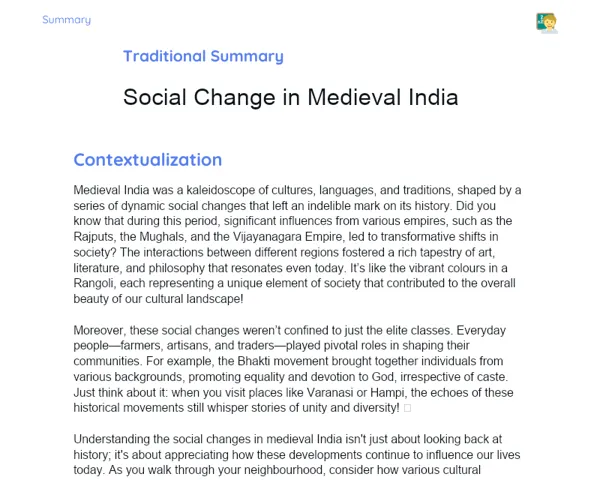## Goals
1. Understand the unique architectural features of Mughal tombs, including their design and structural techniques.
2. Analyze the cultural significance of Mughal tombs within Indian history and their impact on local traditions and art.
3. Develop skills to critically assess historical monuments and their relevance in today's society.
Contextualization
Did you know that the majestic Taj Mahal, one of the Seven Wonders of the World, is a brilliant example of Mughal architecture? The style of constructing tombs during the Mughal era was not just about aesthetics; it involved intricate designs, bringing together Persian, Indian, and Islamic influences. Mughal tombs often feature grand domes, expansive gardens, and detailed inlay work, showcasing the craftsmanship of the artisans of that time. These monuments are not only a feast for the eyes but also a treasure trove of historical stories waiting to be uncovered!
Subject Relevance
To Remember!
Grand Domes
One of the most iconic features of Mughal tombs is their grand domes, which are often bulbous and large, creating an impressive silhouette against the sky. These domes not only serve a structural purpose, providing stability and support to the tomb but also symbolize the heavens and the divine. The artistry in dome design reflects a blend of Persian architectural styles with Indian elements, showcasing the unique fusion that characterizes Mughal architecture. Some notable examples include the domes of the Taj Mahal and Humayun's Tomb, where intricate details and ornate carvings enhance their beauty.
-
Symbol of Divinity: The dome represents a connection between the earth and the heavens, emphasizing the spiritual aspects of the tomb.
-
Structural Innovation: The use of a double dome technique enhances stability and creates a visually stunning effect from both inside and outside.
-
Cultural Fusion: The architectural style reflects a blend of Persian and Indian influences, symbolizing the cultural interconnectedness during the Mughal era.
Expansive Gardens
Mughal tombs are often surrounded by lush gardens, known as 'Charbagh,' which are laid out symmetrically to represent the four gardens of paradise described in Islamic texts. These gardens are meticulously designed and usually feature pathways and water channels, symbolizing life and prosperity. The incorporation of nature into the architectural framework not only enhances the aesthetic appeal but also provides a peaceful environment for reflection and meditation. The gardens serve as a transitional space between the earthly realm and the afterlife, creating a harmonious balance.
-
Symbol of Paradise: The Charbagh layout represents the Islamic concept of paradise, highlighting the cultural and spiritual significance of gardens.
-
Aesthetic Enhancement: Gardens enhance the beauty of tombs, making them serene spaces for visitors and serving as a backdrop for the architectural marvels.
-
Ecological Consideration: The design often includes native flora, promoting biodiversity and sustainability in landscaping practices.
Intricate Inlay Work
The detailing in Mughal tombs showcases the exquisite craftsmanship through intricate inlay work, particularly using semi-precious stones. This technique, known as 'Pietra Dura,' involves embedding shapes of colored stones into marble surfaces to create beautiful floral patterns and designs. The artistry is not merely decorative; it tells stories and conveys emotions, reflecting the skills of artisans who dedicated years to master these techniques. The Taj Mahal is a prime example, where inlay work brings to life the vision of a timeless love story.
-
Artistic Expression: The inlay work is a form of storytelling, where each pattern holds meaning and adds to the narrative of the tomb.
-
Skill Development: The technique requires exceptional skill and precision, showcasing the high level of craftsmanship during the Mughal period.
-
Cultural Legacy: Inlay work has influenced modern art forms and continues to be a source of inspiration for contemporary artisans.
Practical Applications
-
Designing Your Own Monument: Students can create a model of a Mughal-style tomb using materials like clay, cardboard, or paper, focusing on incorporating elements like domes and gardens.
-
Field Research: Students can visit local historical sites or museums to observe and document architectural features influenced by Mughal designs, fostering observational skills and cultural appreciation.
-
Creative Writing: Write a short story or poem inspired by Mughal tombs, reflecting on their beauty and historical significance, which encourages creative expression and research.
Key Terms
-
Mughal Architecture: A style of architecture that combines Islamic, Persian, Turkic, and Indian elements, characterized by grand structures and intricate details.
-
Charbagh: A Persian word meaning 'four gardens,' used to describe the garden layout that divides the area into quadrants, symbolizing Islamic paradise.
-
Pietra Dura: An Italian term for the technique of inlaying colored stones into marble to create decorative patterns and designs.
Questions for Reflections
-
In what ways do you think Mughal tombs reflect the cultural values and beliefs of that era? Discuss how architecture can communicate societal norms.
-
How does understanding the construction style of Mughal tombs enhance your appreciation for our own historical monuments? Write about any local structures that inspire you.
-
What responsibilities do you think we have as young citizens towards preserving our cultural heritage? Reflect on how you can contribute to this effort in your community.
Design Your Dream Mughal Tomb!
Imagine if you had the opportunity to design your own Mughal-style tomb, blending your personal inspirations with the traditional elements you’ve learned. This challenge encourages you to think creatively while maintaining respect for the historical significance of Mughal architecture.
Instructions
-
Sketch the layout of your tomb, including features like domes and gardens.
-
Select colors, materials, and designs that represent your personality and vision.
-
Write a short description of your tomb, explaining what each element symbolizes and why you chose it.
-
Present your design to the class, sharing the inspiration behind your choices and how they reflect the legacy of Mughal architecture.


